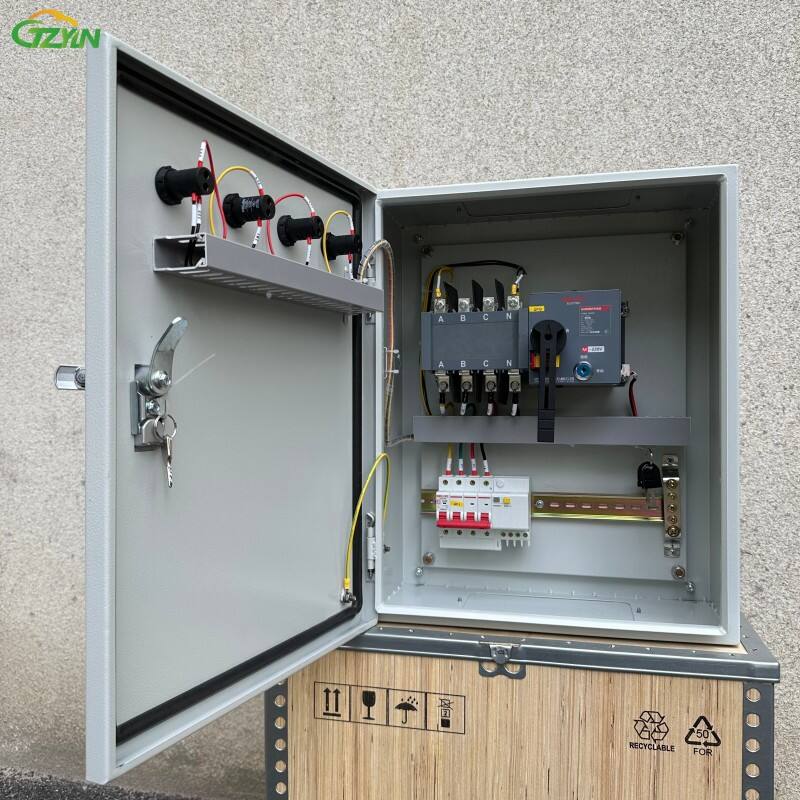Understanding Dual Power Switching Cabinets
Core Components: Transfer Switches and Sub Panel Boxes
Transfer switches and sub panel boxes are key components in dual power switching cabinets. Transfer switches automatically switch between power sources during outages, ensuring uninterrupted power and system reliability. Sub panel boxes efficiently distribute electricity across different areas, reducing power loss and downtime. Together, they improve overall system performance and energy efficiency.
Role of 200 Amp Main Panels in Power Distribution
A 200 Amp main panel is ideal for managing high electrical loads, especially in commercial and industrial settings. It effectively distributes power across extensive equipment networks, making it essential in sectors like manufacturing. Since average load requirements in these environments often exceed standard limits, the 200 Amp panel ensures smooth operations and prevents overloads.
Integration with Control Panel Electrical Systems
Integrating dual power systems with control panel electrical systems greatly improves power management efficiency and safety. This setup allows centralized monitoring and ensures reliable power delivery, especially in critical environments like hospitals, data centers, and manufacturing. It also enhances safety by enabling quick responses to power fluctuations, reducing risks of equipment damage or data loss. Together, these systems create a stable and secure power distribution network across various applications.
Key Benefits of Dual Power Systems
Zero Downtime for Critical Operations
Dual power systems help ensure zero downtime in critical operations by automatically switching to backup power during outages. Using transfer switches and power switching cabinets, these systems detect power loss and respond instantly. Studies show that even brief downtime in sectors like data centers can cause major financial losses. Implementing dual power systems minimizes these risks and strengthens operational reliability.
Scalability with Modular Power Panel Box Designs
One of the standout features of dual power systems is their scalability, particularly through modular power panel box designs. Modular designs allow businesses to easily scale their power capabilities in alignment with operational growth, significantly reducing the need for complete system overhauls. For instance, companies can integrate additional sub panel boxes as they expand, accommodating increased power demands without disrupting operations. A practical case study demonstrates how a logistics company implemented a modular design, which allowed seamless scaling as its operational load increased, demonstrating the power of adaptability and foresight.
Enhanced Safety in High-Density Electrical Environments
Dual power systems significantly enhance safety in high-density electrical environments by incorporating advanced safety features that protect against overloads and short circuits. These systems include built-in safeguards, such as circuit breakers and power distribution boxes, designed to handle large volumes of electricity safely. Adhering to safety standards recommended by electrical safety organizations, such as the National Fire Protection Association (NFPA), these systems ensure compliance and reduce risks associated with high electrical loads. Implementing these systems helps businesses maintain safe operations, ultimately enhancing overall reliability and security in demanding settings.
Applications in Mission-Critical Infrastructure
Data Centers: Powering High-Availability Server Racks
Data centers are at the heart of modern digital infrastructure, and dual power systems ensure they remain operational even in the face of power disruptions. These systems are pivotal in maintaining high-availability for server racks, as any downtime could lead to significant data loss and financial repercussions. According to an industry report, the average cost of data center downtime can exceed $9,000 per minute, stressing the importance of reliability. By utilizing power switching cabinets, data centers can seamlessly transition between power sources, maintaining continuous operation and safeguarding critical data.
Healthcare Facilities: Ensuring Life Support System Continuity
In healthcare facilities, an uninterrupted power supply is non-negotiable, as it directly impacts life support systems and critical medical equipment. Dual power systems are instrumental in these settings, providing a reliable backup during power outages and ensuring continuous operation of life-saving machines. Regulatory bodies, such as the Joint Commission, have established strict requirements for power reliability in healthcare, emphasizing the necessity for these systems. Examples of such mandates can be found in standards like NFPA 99, which guide healthcare facilities in implementing robust power reliability measures.
Industrial Automation: Protecting Control Panel Electrical Networks
For industrial automation, uninterrupted power supply is vital to safeguard control panel electrical networks and ensure ongoing productivity. Dual power systems play a critical role in protecting these networks from power failures, thus minimizing downtime and operational disruption. By integrating dual power setups, industries can reduce operational risks and enhance overall productivity. This protection is built into the design of most control systems, allowing for seamless maintenance and ensuring that the automated processes remain efficient and reliable, even in the event of power interruptions. This integration leads to increased uptime and significant reductions in operational costs.
Technical Specifications and Design Considerations
Voltage Requirements for Power Distribution Box Systems
Understanding voltage requirements is crucial for selecting and operating power distribution boxes effectively. Typically, standard voltage requirements for these boxes range from 120V to 240V, depending on the application and regional electrical standards. This variation ensures compatibility with diverse electrical systems, from residential setups to industrial applications. Adhering to these specifications is not just about ensuring device functionality; it's also critical for safety and compliance with national electrical codes. Failure to meet these requirements can lead to equipment failure and pose significant safety risks.
Redundancy Protocols in Sub Panel Box Configurations
In modern electrical systems, redundancy protocols within sub panel box configurations are fundamental in enhancing system reliability. These protocols involve setting up alternate power paths to ensure continuous power supply during failures or maintenance. Common configurations like N+1 or N+2 redundancy are widely used; where "N" stands for the minimum units needed to meet system demand, "+1" or "+2" signifies extra units for redundancy. These configurations are crucial in critical infrastructures like data centers, where even a momentary power loss can be catastrophic. Redundant systems ensure resilience and operational continuity.
Thermal Management for 200 Amp Main Panel Longevity
Proper thermal management is essential in extending the operational life of 200 Amp main panels. Effective techniques include optimizing airflow and controlling internal heating. Ensuring adequate ventilation prevents overheating, which can degrade performance over time. Research indicates that maintaining temperatures between 65°F to 85°F ensures optimal panel functionality and longevity. Overheating can result in frequent shutdowns and increased maintenance costs. By implementing robust thermal management practices, one can enhance efficiency while significantly reducing the likelihood of power disruptions, thereby improving overall system reliability.
Future Trends in Power Switching Technology
Smart Grid Integration with Control Panel Electrical Systems
Smart grids are revolutionizing modern electrical systems, integrating seamlessly with control panel electrical systems to enhance efficiency and reliability. As industries increasingly adopt smart grid technologies, dual power systems become crucial, allowing for real-time data exchange and advanced energy management. According to industry experts, smart grid adoption is predicted to grow rapidly, driven by the demand for sustainable and efficient power solutions. As this trend continues, organizations can expect enhanced operational efficiency, reduced energy costs, and improved power system management.
AI-Driven Predictive Maintenance for Power Panel Box Networks
AI-driven predictive maintenance is poised to transform power panel box networks by foreseeing and preventing potential outages before they occur. This innovative approach uses data analytics and machine learning to predict equipment failures, enabling proactive maintenance and reducing downtime. In fact, numerous case studies show that companies implementing AI-driven maintenance solutions have observed a significant reduction in operational costs. These systems not only boost network reliability but also optimize maintenance schedules, ensuring continuous power distribution and extending equipment life.
FAQ Section
What are dual power switching cabinets?
Dual power switching cabinets are electrical systems that manage power supply by switching between different power sources during outages, ensuring uninterrupted power distribution.
Why is thermal management important for 200 Amp main panels?
Thermal management is crucial to prevent overheating, ensuring the longevity and optimal performance of 200 Amp main panels.
How do modular power panel boxes enhance scalability?
Modular power panel boxes allow businesses to easily expand their power capabilities, accommodating increased demands without disrupting operations.
What is AI-driven predictive maintenance in power panel networks?
AI-driven predictive maintenance uses data analytics and machine learning to predict equipment failures, enabling proactive maintenance and reducing downtime.
How does smart grid technology integrate with control panel systems?
Smart grid technology integrates with control panel systems to enhance efficiency, allowing for real-time data exchange and advanced energy management.
What are redundancy protocols in sub panel box configurations?
Redundancy protocols involve setting up alternate power paths to ensure continuous power supply during failures, enhancing system reliability.
Table of Contents
- Understanding Dual Power Switching Cabinets
- Key Benefits of Dual Power Systems
- Applications in Mission-Critical Infrastructure
- Technical Specifications and Design Considerations
- Future Trends in Power Switching Technology
-
FAQ Section
- What are dual power switching cabinets?
- Why is thermal management important for 200 Amp main panels?
- How do modular power panel boxes enhance scalability?
- What is AI-driven predictive maintenance in power panel networks?
- How does smart grid technology integrate with control panel systems?
- What are redundancy protocols in sub panel box configurations?


